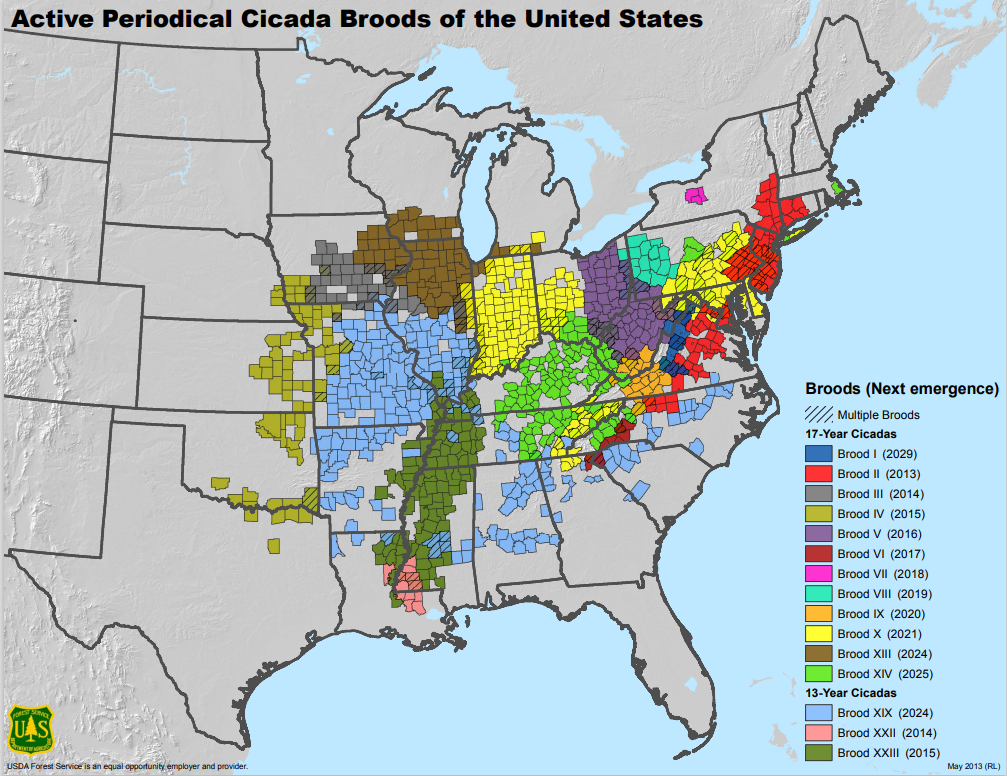Cicada broods soon to emerge. Can we expect them in New York?
Like clockwork, cicadas will emerge in May. And for the first time since 1803, two broods of cicadas will emerge in the U.S. at once. How many of the winged, noisy creatures will appear?
More than a trillion.
"The state of Delaware is roughly 1.5 million acres in size. If we accept an estimate of a million cicadas per acre and if the total combined area of a periodical cicada emergence is roughly the size of Delaware, then more than a trillion cicadas will be involved," the University of Connecticut states.
But most broods do not appear all over in any given year. This year, they won't be seen nor heard in New York.
Set to emerge soon are the 13-year Brood XIX, the largest of all cicada broods, and the 17-year Brood XIII.
Brood XIII will largely be confined to Illinois. Brood XIX will have a larger range, but shouldn't be closer to New York than southern Virginia and northern North Carolina.
What do cicadas eat?: Lifecycle, diet and biting habits explained
But that's this year. Brood XIV will emerge in 2025 in New York, as well as a dozen other states, says Cicada Mania.
What do cicadas look like?
They're not locusts, says Cicada Mania. And they're different in appearances from the cicadas that make annual appearances, which have a green to dark gray body. Periodical cicadas — those that emerge every certain number of years, rather than every year — have black bodies, clear wings and bold red eyes:
What to expect in New York (in 2025)
Cicadas are largely harmless to you and your pets, as they don't bite and they don't sting. Nor are they poisonous. (If your pet eats them, they may get an upset stomach, as the cicadas' exoskeleton is difficult for some animals to digest.) Cicadas only drink tree sap.
And they'll be gone in a month and a half, according to the Purdue University Department of Entomology.

In May 2025, when Brood XIV emerges after 17 years, " ... expect up to 1.5 million cicadas per acre to begin boiling out of the ground," the university states. "Once every 17 years they emerge en masse, climb up trees, sing (though it sounds more like screaming), mate, and lay their eggs on the tips of tree branches."
"They mate, lay their eggs, and then both male and female cicadas die after just about five weeks above ground," National Geographic states.
What's with their screaming?
Cicadas are infamous for their high-pitched buzz. Only males make the ruckus, trying to attract females to reproduce.
The Centers for Disease Control and Prevention says cicadas can reach between 90 and 100 decibels, about as loud as a lawnmower. A sample, and by comparison:
Cicadas bring positives, too
There are benefits to cicadas, according to the Environmental Protection Agency. They provide food for birds and other predators. Cicadas aerate lawns and improve ground water filtration. And once dead, their decomposition adds nutrients to soil.
Cicadas generally want to avoid you and your home. But to keep strays away, consider these steps:
Patch any holes in screen doors and windows. While cicadas can't breed indoors, and thus have little interest in going inside, patching holes can keep stray cicadas out.
Cover patio furniture, pools and hot tubs, especially those underneath trees.
Prune trees and shrubs. Cicadas use trees to mate, so pruning them helps to keep the insects away. Female cicadas make small slits in branches and then lay their eggs on them, so for younger trees and shrubbery, cover them with a garden net, as younger trees may not able to handle the weight.
This article originally appeared on Rockland/Westchester Journal News: 2024 cicadas: Will they emerge in New York?
